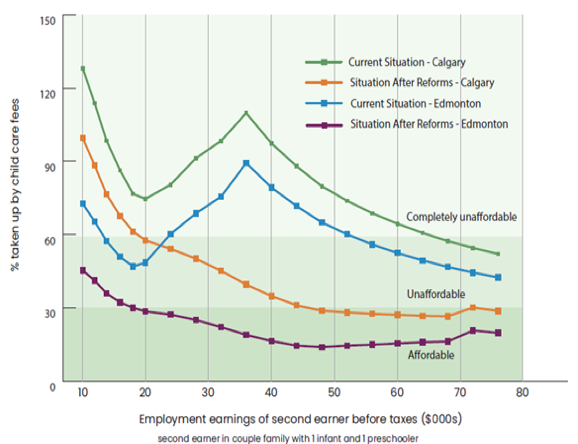Who does $10/day child care actually benefit?
For decades, families and economists have watched as fees for early learning and child care (ELCC) programs have steadily risen and become unaffordable for many. Current costs can act as a barrier to high quality care for some—particularly low-income families—as quality of care is largely dependent on parents’ ability to pay. The federal government’s goal of $10-per-day child care by the end of 2026 aims to make child care affordable for all. However, the question remains, will achieving the $10 a day goal actually make ELCC programs affordable across Canada?
In a landmark study, economists Gordon Cleveland and Michael Krashinsky of the University of Toronto aim to answer this exact question.
Affordable for whom? One of the wicked questions in child care
In order to measure the affordability of the federal government’s new policy, Cleveland and Krashinksy use the Caregiving Parent Affordability Measure to compare the affordability of current child care rates to the target $10-per-day child care rate across Canada. This calculation uses a ratio between cost of child care and family income to determine what is and is not affordable in different regions.
Based on their research, it is evident that current child care rate which range from $30 a day to $66 a day for infants in Manitoba and Ontario respectively – are unaffordable. $10-per-day child care would, on average, be a significant move toward affordable, high quality care for many but not all families. Affordability for all families is extremely difficult to achieve because implementation of $10-per-day care is left at the discretion of individual provinces and territories. While a national child care strategy would be challenging to implement, a siloed approach means that whether or not child care is affordable will be based on how the $10-per-day child care policy is implemented across Canada. Affordability for families will also depend on other factors such as average net income, cost of living, and cost of child care in different regions.
Graph 1 below uses Calgary and Edmonton as an example of this variance. Even after reforms from the $10-per-day policy, child care affordability is not the same across Alberta with child care being more affordable in Edmonton than Calgary.
Graph 1: Comparing past and current ELCC affordability in Calgary and Edmonton

Source: Cleveland and Krashinsky, 2021y.
In addition to geography, affordability is impacted by net family income—with low-income families still paying more proportionately for the same child care. Cleveland and Krashinsky make it clear that to achieve affordable child care for all, provinces and territories need to focus on funding reforms—like sliding scale options— that ensure low-income families are not disadvantaged.
Inequity doesn’t end with $10-per-day child care
Despite the progress made by $10-per-day care, this policy does not address inequities in access to childcare across the country—whether it be for families in rural or remote communities, parents working non-standard hours, or children with special needs/exceptionalities. Now more than ever there is still work to be done to ensure all families across Canada have equitable access to affordable, high-quality, flexible child care.
For more information on the benefits of quality child care, see our September 2021 article, The Human benefits of quality Early Learning and Childcare programs.
